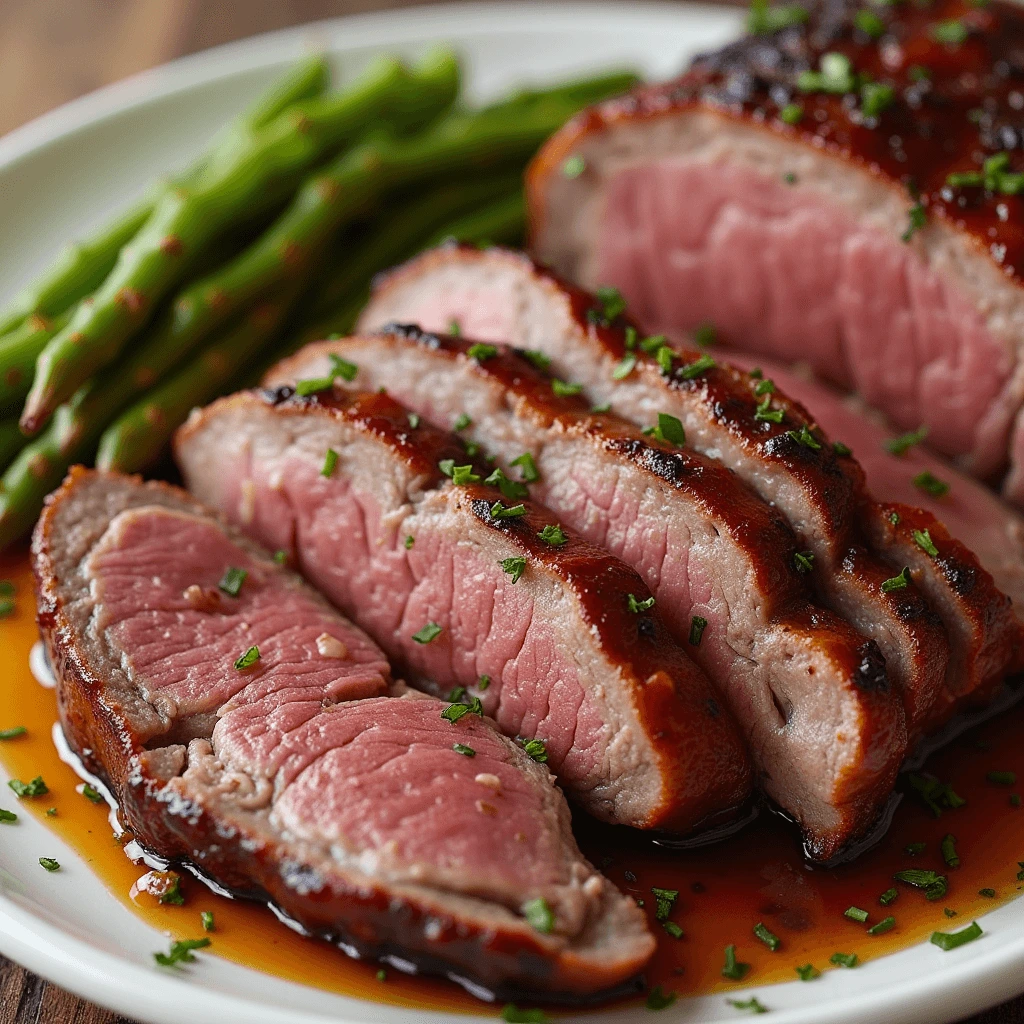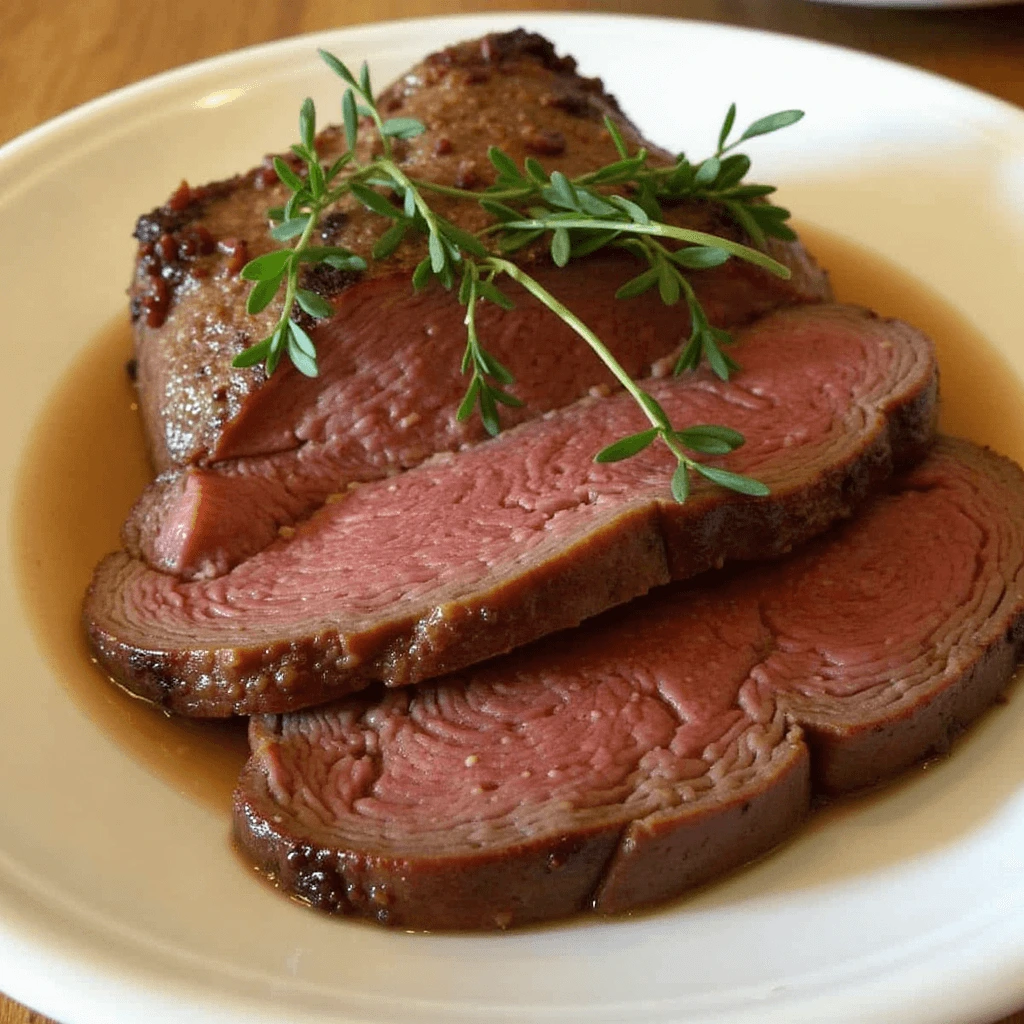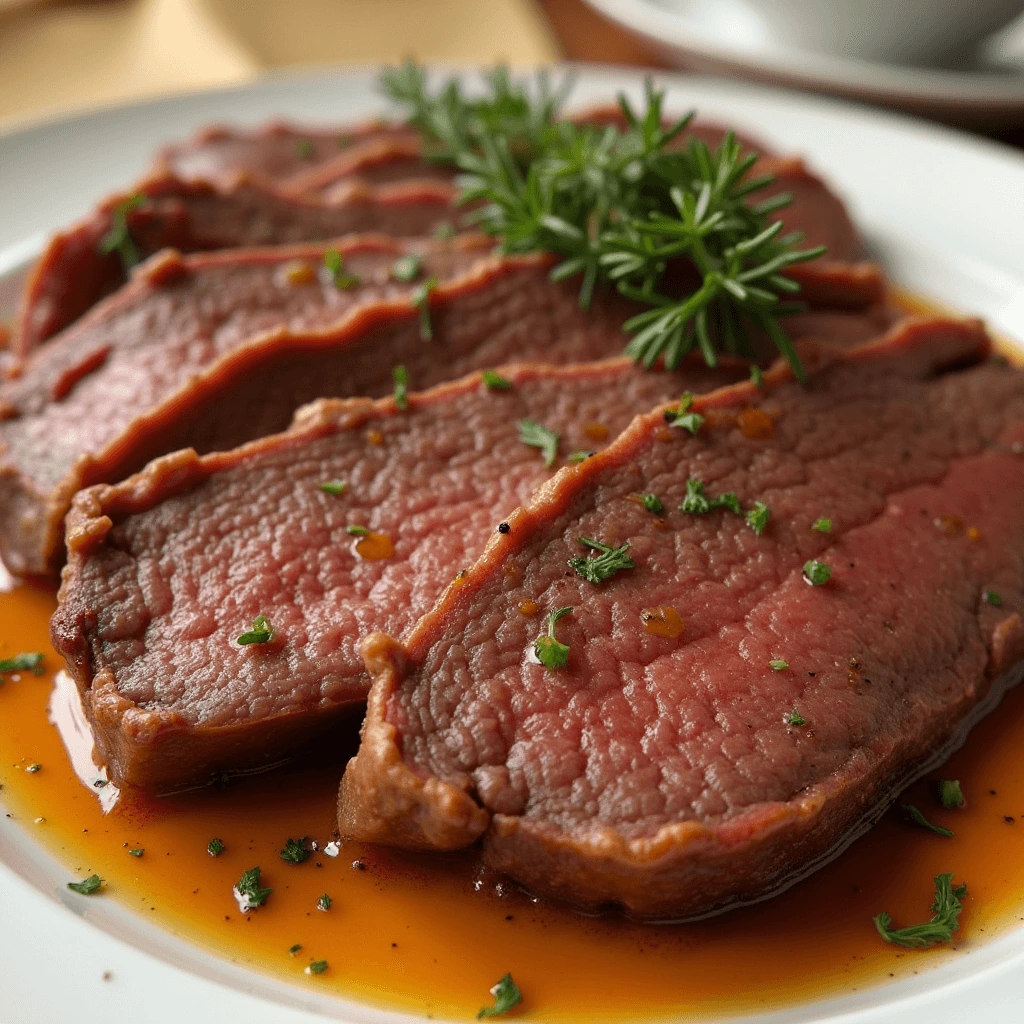Roast Beef Recipe Your Whole Family Will Love (Easy!)
Nothing is worse than a dry or tough roast. This recipe guarantees a juicy, tender roast beef with the right balance of seasonings and cooking techniques. By choosing the right cut of beef and cooking it at the perfect temperature, you’ll achieve a flavorful, melt-in-your-mouth texture that the whole family will love.
- Using a meat thermometer ensures perfect doneness.
- Low and slow roasting helps break down tough fibers for tenderness.
- Resting the beef before slicing keeps the juices locked in.
Quick and Simple Roast Beef Recipe for Busy Cooks
You don’t need to spend hours in the kitchen to make a delicious oven-roasted beef dinner. This recipe is designed to be easy and foolproof, with minimal prep time and hands-off cooking.
- Simple seasoning with pantry staples (salt, pepper, garlic, and herbs).
- Minimal effort—just season, roast, and let the oven do the work!
- Perfect for weeknight dinners or Sunday family meals without the stress.
Perfect Family-Friendly Beef Roast for Dinner
This family-friendly roast beef recipe is a crowd-pleaser. It’s hearty, flavorful, and pairs well with a variety of side dishes. Whether you’re serving it with mashed potatoes, roasted vegetables, or warm dinner rolls, everyone at the table will enjoy it.
- A great comfort food option for family gatherings.
- Kid-friendly with a mild yet savory seasoning.
- Works for special occasions, holidays, or a simple Sunday roast.
How to Choose the Best Cut for a Perfect Roast Beef Recipe
Best Beef Cuts for Roasting: Chuck, Ribeye, or Sirloin?
Choosing the right cut of beef is essential for achieving a tender and flavorful roast beef. Some cuts are naturally more tender, while others benefit from slow roasting to break down tougher fibers. These cuts are among the top choices for this dish:
- Ribeye Roast – One of the most flavorful and tender options, with beautiful marbling that keeps the meat juicy.
- Sirloin Roast (Top Sirloin or Bottom Sirloin) – Leaner than ribeye but still full of beefy flavor. Best when cooked to medium-rare or medium.
- Chuck Roast – More affordable and slightly tougher, but slow roasting makes it incredibly tender and delicious.
- Eye of Round Roast – A lean cut that’s budget-friendly. Needs careful cooking to avoid drying out.
- Tenderloin Roast (Beef Tenderloin or Filet Roast) – The most tender option, though typically more expensive.
Each of these cuts works well for different types of roast beef recipes, depending on whether you prefer juicy and marbled beef or leaner, firmer meat.
Why Marbling Creates a Juicy and Flavorful Roast
Marbling refers to the small flecks of fat dispersed throughout the muscle fibers of the meat. These fat deposits melt during cooking, keeping the roast moist, tender, and full of rich beefy flavor.
- High-marbled cuts like ribeye roast are naturally tender and flavorful.
- Leaner cuts like eye of round roast need extra care (such as basting or using a marinade) to prevent dryness.
- A balance of fat and muscle fibers ensures a roast that stays juicy without being overly greasy.
When selecting a roast, look for good marbling but avoid excessive external fat, which won’t render as well during cooking.
Bone-In vs. Boneless Roast Beef: Pros and Cons
When buying a beef roast, you’ll often have the choice between bone-in or boneless cuts. Each has its own benefits:
Bone-In Roast Beef
- More flavor – The bone adds richness and depth to the meat.
- Even cooking – The bone helps regulate heat distribution.
- Great for presentation – Looks impressive when served whole.
Boneless Roast Beef
- Easier to carve – No bones to work around when slicing.
- Cooks faster – Bone-in cuts may take slightly longer.
- More seasoning coverage – Can be fully coated with spices and herbs.
If you prefer maximum flavor and don’t mind extra carving, go for a bone-in rib roast. If you want something simpler and quicker to prepare, a boneless sirloin or chuck roast is a great choice.
Step-by-Step Guide to Cooking the Best Oven-Roasted Beef

How to Season Your Roast Beef for Maximum Flavor
Seasoning is key to bringing out the natural richness of roast beef. A well-seasoned roast creates a flavorful crust while keeping the inside tender and juicy.
- Basic Seasoning Blend – Start with kosher salt and freshly ground black pepper. These simple ingredients enhance the beef’s natural flavor.
- Garlic and Herbs – Fresh garlic, rosemary, and thyme add depth and aroma. You can also use dried spices for convenience.
- Olive Oil or Butter – Rubbing the roast with olive oil or melted butter helps the seasoning stick and creates a beautifully browned crust.
- Optional Flavor Enhancers – Add a splash of Worcestershire sauce, Dijon mustard, or soy sauce for extra umami.
- Marinate or Dry-Brine? – For maximum flavor penetration, let the roast rest in the fridge for at least 1–2 hours (or overnight) after seasoning. This allows the salt to break down muscle fibers for a more tender result.
Oven Temperature and Cooking Time for a Tender Beef Roast
The right oven temperature and cooking time will ensure your roast beef is cooked evenly and stays juicy.
- Start with High Heat (450°F/230°C) – Searing the roast at a high temperature for the first 15–20 minutes locks in juices and creates a delicious crust.
- Reduce the Temperature (325°F/160°C) – After searing, lower the heat to slow roast the beef, ensuring even cooking.
- General Cooking Times Per Pound:
- Rare (120–125°F / 49–52°C): 15–17 minutes per pound
- Medium-Rare (130–135°F / 54–57°C): 18–20 minutes per pound
- Medium (140–145°F / 60–63°C): 20–22 minutes per pound
- Well-Done (155–160°F / 68–71°C): 25+ minutes per pound
Cooking times vary based on the cut of beef, oven type, and thickness, so using a meat thermometer is essential!
Using a Meat Thermometer to Cook Roast Beef Perfectly
A meat thermometer is the best way to ensure your roast beef is cooked exactly how you like it.
- Insert the thermometer into the thickest part of the roast, avoiding bones or fat pockets.
- Check temperatures early to avoid overcooking. The roast will keep cooking while it rests.
- Target internal temperatures:
- Rare: 120–125°F (49–52°C)
- Medium-Rare: 130–135°F (54–57°C)
- Medium: 140–145°F (60–63°C)
- Well-Done: 155–160°F (68–71°C)
Pro Tip: Remove the roast from the oven 5–10°F before the target temperature—it will rise a few degrees while resting.
Why Resting the Roast Beef is Key for Juicy Slices
Resting is just as important as cooking because it allows the juices to redistribute inside the meat.
- Give the roast 15–20 minutes to rest before slicing.
- Cover it loosely with aluminum foil to keep it warm without trapping steam.
- Slicing too soon = dry meat! Cutting into the roast immediately will cause the juices to spill out, making it less juicy.
For the best texture and juiciness, always slice against the grain using a sharp knife.
Best Side Dishes to Serve with an Easy Roast Beef Dinner
Mashed Potatoes, Roasted Veggies, and Other Classic Pairings
Roast beef pairs wonderfully with hearty and comforting sides that balance the rich flavors of the beef. Here are some classic and crowd-pleasing options:
- Creamy Mashed Potatoes – The smooth, buttery texture of mashed potatoes is a perfect match for tender roast beef. You can add garlic, sour cream, or chives for extra flavor. For an indulgent twist, try loaded mashed potatoes with bacon bits and cheese.
- Roasted Vegetables – Roasted carrots, parsnips, or Brussels sprouts are a fantastic complement. Toss vegetables in olive oil, salt, pepper, and herbs before roasting at 400°F (200°C) for 25–30 minutes until caramelized. The natural sweetness of the veggies enhances the savory beef flavors.
- Grilled Asparagus or Green Beans – Tender asparagus or crisp green beans lightly sautéed in garlic butter can add a fresh, bright contrast to the richness of the roast.
- Sweet Potatoes – Whether mashed or roasted, sweet potatoes offer a slightly sweet flavor that pairs beautifully with the savory, meaty beef. Try roasted sweet potato wedges seasoned with rosemary and olive oil for a delicious side.
Homemade Beef Gravy Recipe Using Pan Drippings
No roast beef dinner is complete without a rich, savory gravy made from the beef drippings. Here’s how to make it:
- Collect the drippings from the roast pan. After removing the roast, set the pan over medium heat and add a splash of beef broth or red wine to deglaze the pan.
- Make a roux by mixing flour with a bit of fat from the drippings, then cook for a minute or two until it thickens.
- Gradually whisk in beef broth, stirring constantly, until the gravy reaches your desired consistency.
- Season with salt, pepper, and herbs like thyme or rosemary for extra depth. For an added twist, a spoonful of Worcestershire sauce or a splash of heavy cream can make it extra decadent.
The savory gravy will elevate the entire meal, pouring beautifully over mashed potatoes and roast beef slices.
Fresh Salads and Buttered Rolls for a Complete Meal
For a balanced and complete meal, consider adding a fresh salad and some buttery rolls to the table. These light sides provide a contrast to the rich roast beef while rounding out the meal.
- Simple Green Salad – A fresh salad with mixed greens, cucumber, and cherry tomatoes tossed in a light vinaigrette can help cut through the richness of the roast. You can also add feta cheese, walnuts, or cranberries for extra texture and flavor.
- Caesar Salad – For something more indulgent, a classic Caesar salad with crisp romaine lettuce, creamy dressing, croutons, and parmesan cheese pairs excellently with roast beef.
- Dinner Rolls – Soft, buttered dinner rolls are a staple at any roast beef dinner. Their mild flavor and fluffy texture make them perfect for sopping up gravy and juices. You can also serve garlic bread or crescent rolls for a more flavorful twist.
- Coleslaw – If you prefer a slightly tangy contrast, a creamy coleslaw made with cabbage and carrots can provide a refreshing crunch alongside the beef.
Wine Pairings to Complement Roast Beef
Though not a side dish, selecting the right wine can elevate your roast beef dinner to the next level. Pairing the beef with a wine that complements its rich flavors can enhance the entire dining experience.
- Full-bodied red wines like Cabernet Sauvignon, Merlot, or Malbec are great choices. Their bold tannins and dark fruit notes work well with the savory, beefy flavors of roast beef.
- If you prefer white wine, go for a Chardonnay with a touch of oak, as it can complement the richness of the roast.
- For a lighter option, a Pinot Noir provides a nice balance without overpowering the flavors of the beef.
By pairing the right wine, you can elevate your meal, making it even more memorable for family and guests.
How to Store, Reheat, and Use Leftover Roast Beef

Best Ways to Store Roast Beef in the Fridge or Freezer
Proper storage is essential to ensure your leftover roast beef stays fresh and safe to eat. Storing it correctly will preserve its flavor and texture for future meals.
- In the Refrigerator
- Cool it down quickly – Let your roast beef cool to room temperature (no more than two hours after cooking) before storing it. This helps prevent bacteria growth.
- Wrap tightly – Wrap the leftover roast beef in plastic wrap, aluminum foil, or parchment paper. For added freshness, place it in a resealable plastic bag or airtight container.
- Storage time – Leftover roast beef will stay fresh in the refrigerator for 3–4 days. After this time, it may begin to lose flavor and moisture.
- In the Freezer
- Freeze promptly – If you won’t use the leftover roast beef within a few days, freezing is the best option. Slice or portion the beef into meal-sized servings before freezing to make future meals easier.
- Wrap and bag – For optimal freezing, wrap the roast beef tightly in plastic wrap or freezer paper, then place it inside a freezer bag or airtight container to prevent freezer burn.
- Storage time – Roast beef can be stored in the freezer for up to 3 months. For optimal quality, consume it within 1–2 months.
How to Reheat Roast Beef Without Drying It Out
Reheating roast beef can be tricky, as it’s easy to dry it out or overcook it. However, with the right methods, you can restore its juiciness and flavor:
- Reheating in the Oven
- Preheat your oven to 300°F (150°C).
- Place the leftover roast beef on a baking sheet and cover it loosely with aluminum foil to keep it from drying out.
- Heat for 10–15 minutes, depending on the thickness of the meat. Check the internal temperature, aiming for 120–130°F (49–54°C) for medium-rare to medium roast beef.
- To add extra moisture, sprinkle beef broth or gravy over the slices before reheating.
- Reheating in the Microwave
- Place slices of roast beef on a microwave-safe plate.
- Pour in a small amount of beef broth or water to keep it moist. Cover the plate with a microwave-safe cover or a damp paper towel.
- Reheat in 30-second intervals, checking the temperature after each interval to avoid overcooking. Microwaving is convenient but can make the beef less tender than the oven method.
- Reheating on the Stovetop
- Heat a non-stick skillet over medium heat. Add a small amount of beef broth or olive oil to the pan.
- Add the sliced roast beef and heat for 2–3 minutes per side. Stir occasionally to avoid burning. This method can help keep the beef moist and flavorful without drying it out.
Creative Leftover Roast Beef Recipes: Sandwiches, Tacos, and More
Leftover roast beef recipe is a great base for a variety of quick and tasty meals. Get creative and turn your leftovers into something new and exciting!
- Beef Sandwiches – Thinly slice the leftover roast beef and turn it into tasty sandwiches. Pair with horseradish sauce, mustard, or aioli, and add fresh veggies like lettuce, tomato, and pickles for extra crunch. Open-faced roast beef sandwiches with melted cheese and gravy are another hearty option.
- Beef Tacos or Burritos – Warm the leftover beef in a skillet, then shred or slice it for tacos or burritos. Add salsa, cheese, lettuce, and sour cream for a quick Tex-Mex meal. You can also use taco seasoning or chili powder to give it extra flavor.
- Beef Stir-Fry – Thinly slice the leftover roast beef and use it in a quick stir-fry with fresh vegetables like bell peppers, onions, and broccoli. Stir in soy sauce, ginger, and garlic for a tasty Asian-inspired dish. Pair it with rice or noodles for a full meal.
- Beef Hash – Dice the leftover roast beef and mix it with potatoes, onions, and peppers for a hearty breakfast or brunch. Serve with a fried egg on top for an extra indulgent touch.
- Beef Soup or Stew – Shred the leftover roast beef and add it to a beef broth-based soup or stew. This is particularly great with root vegetables such as carrots, potatoes, and parsnips. Simmer for a cozy, comforting meal that maximizes the leftover beef’s flavor.
Conclusion

Making roast beef at home is an incredibly satisfying experience that brings the family together around the table. This easy recipe ensures a tender, juicy roast every time, with minimal effort and maximum flavor. Whether you’re cooking for a special occasion or a weeknight dinner, this roast beef recipe is a great way to create a memorable meal without the stress of complicated preparation.
- The simple seasoning and easy steps make it perfect for both beginners and experienced home cooks.
- The flexibility in choosing cuts of beef allows you to tailor the recipe to your budget and preference, from a fancy tenderloin to a more affordable chuck roast.
- Pair it with a variety of side dishes, from mashed potatoes to fresh salads, to create a balanced, delicious meal the whole family will love.
A Recipe That’s Both Versatile and Delicious
One of the best things about roast beef is its versatility. Once you’ve perfected the roasting technique, you can experiment with different seasonings, side dishes, and cooking methods to suit your taste. Plus, roast beef leftovers can be transformed into quick and tasty meals, from sandwiches to stews.
By mastering this easy roast beef recipe, you’ll have a go-to meal that works for any occasion. Whether you’re serving it for a holiday feast, a Sunday dinner, or just a regular weeknight, it’s a recipe that’s sure to impress your family and guests. Plus, it leaves plenty of room for creativity in the kitchen, making each roast a new opportunity to explore different flavors and textures.
A Delicious and Rewarding Meal for Every Occasion
Finally, roast beef is more than just a meal; it’s an experience. The aroma of the beef roasting in the oven, the sizzling sound as it’s carved, and the first bite that melts in your mouth are all part of the experience that brings people together. This recipe ensures that every step, from seasoning to serving, is simple and enjoyable.
Feel free to give this simple roast beef recipe a go. With its flavorful, tender roast and easy-to-follow steps, it’s a dinner that will bring smiles to your family’s faces and leave you with leftovers that are just as delicious the next day. Happy cooking!

